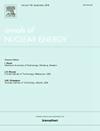Comparison of Advanced-Technology-Fuel options in soluble boron-free Small Modular Reactors
IF 1.9
3区 工程技术
Q1 NUCLEAR SCIENCE & TECHNOLOGY
引用次数: 0
Abstract
Water-cooled Small Modular Reactors (SMRs) have gained significant attention as they could be modularised, standardised, and factory-fabricated to reduce capital cost and improve passive safety. However, SMRs often come with lower power density, which makes them less competitive with commercial LWRs. To enhance SMRs’ operation margin, deployment of the Advanced Technology Fuels (ATFs) can be beneficial. Therefore, this study examines the application of short-term ATF solutions in a soluble boron-free (SBF) SMR design inspired by Rolls Royce’s SMR. The analysis integrates neutronic and thermo-mechanical performance evaluations by means of advanced nuclear modelling tools: WIMS, PANTHER, and TRANSURANUS. The study focuses on core design parameters, including reactivity control, power distribution, shutdown margin and other design limits. In addition, fuel performance was investigated in terms of fission gas release (FGR), fuel temperature and cladding strain. The neutronic analyses suggest that the maximum peaking factors of SBF cores are about 15% higher than those of soluble boron-controlled cores. The deployment of FeCrAl cladding, Cr coating of conventional Zricaloy cladding and Cr doping of UO fuel have a minor impact on both total power peaking and axial offset. On the other hand, the thermo-mechanical results show that Cr-doped fuel and Cr-coated cladding significantly improve fuel performance, reducing FGR and fuel temperature, while FeCrAl cladding offers limited benefits under the evaluated conditions. Comparative analyses indicate that SBF cores, while operationally viable, present unique design challenges due to a higher power peaking and associated thermal fluctuations, necessitating optimisation of control rod strategies and fuel assembly design. The findings demonstrate the feasibility of incorporating ATFs in SBF SMRs, aligning with European green taxonomy criteria for sustainable nuclear development. This study highlights the potential of combined Cr-doped fuel and Cr-coated cladding as a promising strategy to enhance performance in advanced nuclear reactor designs.
求助全文
约1分钟内获得全文
求助全文
来源期刊

Annals of Nuclear Energy
工程技术-核科学技术
CiteScore
4.30
自引率
21.10%
发文量
632
审稿时长
7.3 months
期刊介绍:
Annals of Nuclear Energy provides an international medium for the communication of original research, ideas and developments in all areas of the field of nuclear energy science and technology. Its scope embraces nuclear fuel reserves, fuel cycles and cost, materials, processing, system and component technology (fission only), design and optimization, direct conversion of nuclear energy sources, environmental control, reactor physics, heat transfer and fluid dynamics, structural analysis, fuel management, future developments, nuclear fuel and safety, nuclear aerosol, neutron physics, computer technology (both software and hardware), risk assessment, radioactive waste disposal and reactor thermal hydraulics. Papers submitted to Annals need to demonstrate a clear link to nuclear power generation/nuclear engineering. Papers which deal with pure nuclear physics, pure health physics, imaging, or attenuation and shielding properties of concretes and various geological materials are not within the scope of the journal. Also, papers that deal with policy or economics are not within the scope of the journal.
 求助内容:
求助内容: 应助结果提醒方式:
应助结果提醒方式:


